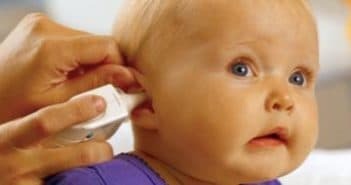
Otitis is one of the diseases that are very common in young children. Mostly this happens to inexperienced mothers, who know little more and can provoke this disease in the child by their own actions. The disease is classified as uncomplicated, quickly docked, well treatable, but only on condition of timely assistance.
Contents of
Features of pediatric otitises
Features of pediatric otitis
The diagnosis of otitis is made at the time when acute inflammation in the ear is established. But it can be different:
- external;
- internal.
More often the diagnosis is: inflammation( otitis) of the middle ear. Baby ears have a slightly different structure than adults. Behind the tympanic membrane is the middle part of the ear, in which the Eustachian tube is located. It serves to connect our nasopharynx with the ears. In an adult it is longer and narrower than a small child. It is because of the short tube that babies are more prone to ear infections. Infection penetrates faster, mucus appears. And if this mucus thickens, clogs the tube itself, otitis begins. And here is how the external diffuse otitis looks, and how it is treated, you can see here.
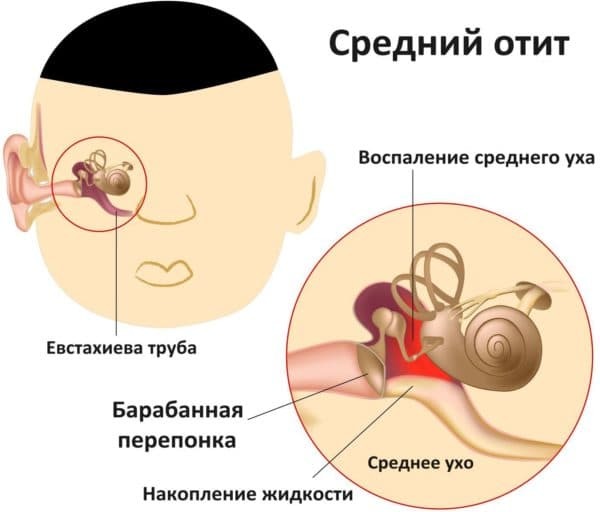
Most often, the diagnosis of a doctor is as follows: inflammation( otitis) of the middle ear.
As the child grows the structure changes, adenoids may appear. Adenoids are quite dangerous for babies, as they can become highly inflamed as a reaction to the entry of pathogenic bacteria.
And here what antibiotics for otitis in adults are used primarily and as they are called, is set forth here.
Causes and Risk Factors
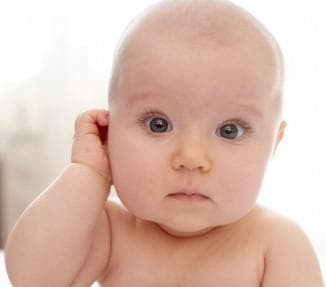 The most common cause is infectious. A light breeze on the damp head of the baby is enough to provoke the disease. Bathing a baby in a cool room, drafts, hypothermia are all causes for otitis. Since the ear is closely associated with the nasopharynx, the mother should know that the ear and nose are more likely to "solo" together or provoke each other. Thus, a clogged spout may well cause otitis. It is recommended to take care of the baby from such a combination, as the treatment procedure will bring pain and anxiety for the crumbs.
The most common cause is infectious. A light breeze on the damp head of the baby is enough to provoke the disease. Bathing a baby in a cool room, drafts, hypothermia are all causes for otitis. Since the ear is closely associated with the nasopharynx, the mother should know that the ear and nose are more likely to "solo" together or provoke each other. Thus, a clogged spout may well cause otitis. It is recommended to take care of the baby from such a combination, as the treatment procedure will bring pain and anxiety for the crumbs.
Otitis can appear in newborn babies, to whom the mother forgets to give a regurgitate after eating and immediately puts it. That is, otitis largely depends not only on the structure of the child's ear, but also on the behavior of the mother herself.
And the vodka looks like tubo-otitis eustachiitis and how it is treated is set forth here.
In addition to human and anatomical factors, there are several more reasons for the onset of the disease:
- the presence of allergy;
- pathology of the respiratory system;
- low immunity.
You may also be interested in learning about antibiotics for otitis media in adults that should be used first.
Often a child suffers from otitis until the year, which is on artificial feeding. No artificial food can replace mother's milk. It is necessary to carefully monitor such a baby and protect from cold and infections. A little later, when the baby becomes more mature, he will outgrow this risk, most likely.
The first symptoms of
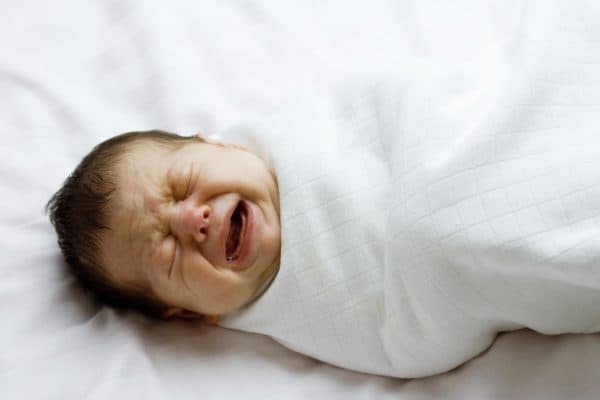
The first signs of otitis are difficult to recognize even to a considerate mother.
A baby girl can not show her mother a source of anxiety. Therefore, the first signs, for example, the first "shooting", zalozhennost, my mother will miss. For her, the baby will be completely healthy in the daytime, but by the evening will begin to be capricious, to cry. And then everything depends on the mother's attention. A sick kid can show signs indicating pain in the tummy. But it can be high temperature, vomiting. The child can ask to eat, but at the first attempts to suck his chest immediately rolls up in hysterics. How to understand such a symptom in a child up to a year? Such crying is explained by the fact that sucking increases the pain in the ear.
To make sure that the baby is tortured by the ear, you need to touch his tragus. A tragus is a cartilaginous projection in front of the ear. A sick otitis baby will try to get away from Mom's attempts, touch will cause a new attack of crying, as the pain intensifies.
And here's how acute diffuse otitis externa is, and how it is treated is indicated here.
However, with external otitis the tragus may well be painless. Therefore, be sure to look into the very ear of the baby, if possible, dunk the cotton inside. Some forms of otitis give a secretion. But in any case, with the slightest suspicion, you do not need to try to recognize the otitis and make a diagnosis yourself, the baby needs to be shown to a specialist.
You may also be interested in information on how treatment of catarrhal otitis occurs in adults.
Diagnosis
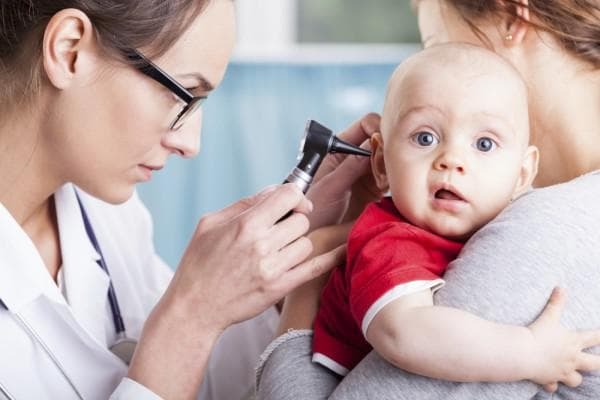
The doctor diagnoses otitis with the otoscope
The standard way to diagnose otitis is to examine the ear with an otoscope. Otoscope - a special device by the type of a short pipe with built-in lighting inside. The doctor inserts the device in the ear, moves closer to the membrane and turns on the light. So the specialist will be able to establish the form of otitis, determine the presence of fluid behind the membrane and decide the question of the appropriateness of paracentesis, shunting.
For complex otitis media, an audiogram is additionally assigned. A painless process in which a toddler wears earphones and tries to determine the degree of hearing loss. However, this is often practiced in already grown-up babies, because crumbs can not yet show what they hear or what they do not.
And here's what bullous otitis in children looks like and what treatment it is necessary to carry out here.
Treatment of
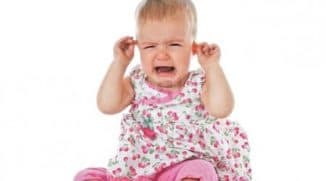 Treatment of otitis media is possible only medically and with the assistance of a physician. It is unacceptable to take steps on your own, as this can worsen the situation and cause more serious consequences.
Treatment of otitis media is possible only medically and with the assistance of a physician. It is unacceptable to take steps on your own, as this can worsen the situation and cause more serious consequences.
Treatment depends on how difficult the otitis media is and what caused it. The most common procedure is a procedure like paracentesis. Note at once: the procedure can be painful even when taking into account local anesthesia. When paracentised, the doctor makes an incision of the tympanic membrane in order to provide an outflow of pus or pumping out fluid. Sometimes after this put a shunt: a small "cog", which does not allow the hole to close until all pus leaves the cavity. Also it is worth to learn more about how treatment with drops of external otitis occurs.
Almost always the baby is assigned to wash the ear and drops for the spout and ear. Here there will be complications, because bury the ears babies are not given. You need to put it on the barrel, try to distract something, and the second parent heats up a little drop.
And here's how the adhesive otitis media looks and what you can do with this problem is indicated here.
Do not drip cold drops in the ear of the baby! This will increase the pain and cause the child to suffer even more.
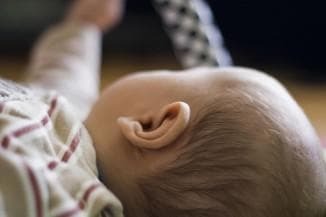 Before dripping, gently clean the passage, only no sticks and matches. Just twist the cotton wool into thin "sticks" and clean the ears with them. The nose must be instilled with vasoconstrictive drops, it does not matter if there is a runny nose in the baby.
Before dripping, gently clean the passage, only no sticks and matches. Just twist the cotton wool into thin "sticks" and clean the ears with them. The nose must be instilled with vasoconstrictive drops, it does not matter if there is a runny nose in the baby.
If you managed to turn to lor on time and the otitis did not manage to develop to purulent, did not form a lot of fluid, then only therapy will be needed: antibiotics, vasoconstrictors, warming up( in the absence of temperature).
If your doctor sends you for warming up at a temperature, immediately change the doctor! The presence of temperature indicates a progressive infection, and heating will only spur its development.
You may also be interested in learning about what are the effective ear drops for otitis for children.
Video
Watch a video about how otitis occurs in toddlers, and why some people get sick often, but others do not:
Otitis is a serious disease even for an adult. Tightening of the otitis leads to abscesses, when the count goes already on the clock. Traditional medicine here is not just powerless, but it can also hurt. The only time when it is appropriate is when there is a combination of otitis, for example, with laryngitis or sinusitis. Here, broths and tinctures are allowed to reduce the effect of the second disease, but not otitis. Otitis always requires a strictly professional treatment.
